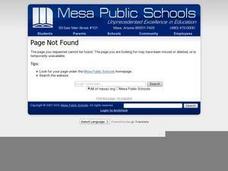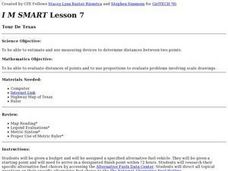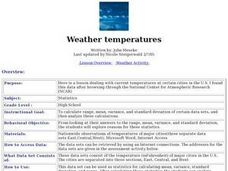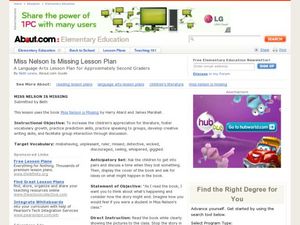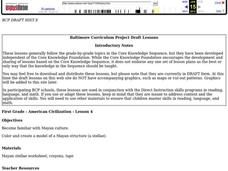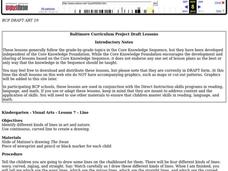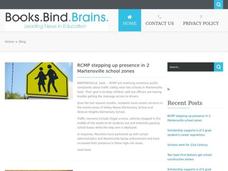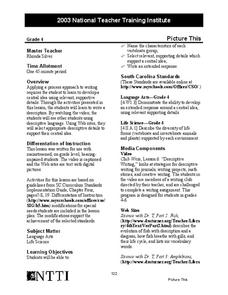Curated OER
Roman Numerals
Fourth graders are introduced to the roman numerals C and L. Students are given a worksheet to complete using previously taught roman numerals and the newly introduced ones. Students complete the second half of the worksheet...
Curated OER
Bar Graphs
Third graders examine the main parts of a bar graph and how to round up to the nearest tenth. They make an example of a bar graph and answer questions based on the graph using a list of state capitals and their average temperatures....
Curated OER
M&M Exponential Activity
Young scholars create a scatter plot of their experimental data. In this algebra lesson, students use M&M's to determine an algebraic model. They discuss results in class.
Curated OER
Graphing
Seventh graders identify the different graphs used in science. In this graphing lesson, 7th graders analyze the three kinds of graphs. They construct a graph that best describes a given data.
Curated OER
Sunrise/Sunset
Students apply data from a weather-related website to predict patterns in the sunrise and sunset.
Curated OER
Thermometers Rising
Third graders read a Fahrenheit thermometer from an actual thermometer. In groups, they are provided with ink pads and a thermometer stamp. They use the stamps on plain white paper and use red pencil to take the temperature readings.
Curated OER
Partner Time and Addition
Students use the Kid Pix program to design addition problems, using the "stamp", "line" and "A" tools and partners type the answers to the problems. Partners switch back to their original computer and check the problems.
Curated OER
Stars and Stripes
Students design a United States flag using reasoning. They describe their design to make it easy for it to be duplicated. They share their designs with the class.
Curated OER
Water Quality Monitoring of Natural Water
High schoolers set up their own monitoring system. They collect samples from an appropriate sampling site. They analyze data and determine the water quality. They present their information to the class and draw a conclusion.
Curated OER
Now You See Me, Now You Don't
Second graders develop an awareness of the power of their minds to work with visual images. All the activities in this unit help strengthen visualization that is an important tool or process in Geometry.
Curated OER
Tour De Texas
Young scholars are given a budget and an alternative-fuel vehicle. Using a map of Texas, they are given a starting point and determine how to arrive at their destination within 72 hours. They use the internet to research the...
Curated OER
Weather temperatures
Young scholars investigate the given statistics about temperatures in cities around the nation in order to look for a pattern. They measure the mean, median, and mode for the data set of temperatures.
Curated OER
New to School Student Booklets
Students create a book about their school experience entitled, "(Student's name) Goes to School." They identify who their friends are and discuss and list them as one page in their booklets. Students also listen to a story read by the...
Curated OER
Basic Geometric Constructions
Students observe and demonstrate a variety of basic geometric constructions using the Triman Safety Compass. Using the compass, they draw circles, bisect a line segment, construct an angle, bisect an angle, copy an angle, and create...
Curated OER
Diet Evaluation Project
Middle schoolers record two consecutive days of food intake. They identify which nutrients are below 70%. They compare diet composition between protein, fats, and carbohydrates. They evaluate fat in the diet to fall below the American...
Curated OER
Miss Nelson is Missing Lesson Plan
Second graders listen to the story Miss Nelson is Missing by Harry Allard and James Marshall. In this literature activity, 2nd graders predict the story's ending with drawings and discussions within groups.
Curated OER
Classification: Dichotomous Key
Students investigate the classification process and nomenclatures used for classifying organisms. They study dichotomous keys to identify organisms with 90% accuracy. Students organize information regarding the relatedness of species.
Curated OER
American Civilization
First graders become familiar with Mayan culture, Aztec civilization and the Inca Empire.
Curated OER
Visual Arts
Students identify different kinds of lines in art and nature. They use continuous, curved line to create a drawing.
Curated OER
Quilting
Second graders make a quilt. In this cultural diversity lesson plan, 2nd graders review their knowledge of the Metis people. Students work in groups to create a class quilt that illustrates the lives of these people. Quilt themes include...
Curated OER
Twirly Whirly Milk
Student observe the effect soap (or detergent) has on the movement of food color in milk. Pupils observe the properties of solids and liquids while making butter. They read a poem, Shaking, and listen for ryhming words. Studdents...
Curated OER
Wildflower Beautification Project
Students, in cooperative groups, design and create a wildflower garden for the community. They write letters to property owners requesting use of their land and then write invitations to their parents and to local, state, and federal...
Curated OER
Write a Description
Finding the central idea is the focus of this lesson. Middle schoolers write descriptions of different animals using details and descriptive language. They watch a video of kids using descriptive language, and then use showing language...
Gwinnett County Public Schools
Analysis of the Tuck Everlasting and The Birchbark House Text Exemplars
Looking to introduce some text-based questions into your ELA lessons? Practice the kinds of skills the Common Core demands with the seven text-based questions and the essay prompt provided here. Designed to be a three-day lesson, day one...






